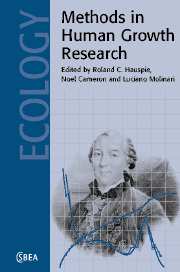Book contents
- Frontmatter
- Contents
- List of Contributors
- Foreword
- Acknowledgements
- Part I Growth data and growth studies: characteristics and methodological issues
- Part II Non-parametric and parametric approaches for individual growth
- 7 Kernel estimation, shape-invariant modelling and structural analysis
- 8 Parametric models for postnatal growth
- 9 Parameter estimation in the context of non-linear longitudinal growth models
- Part III Methods for population growth
- Part IV Special topics
- Index
7 - Kernel estimation, shape-invariant modelling and structural analysis
Published online by Cambridge University Press: 17 August 2009
- Frontmatter
- Contents
- List of Contributors
- Foreword
- Acknowledgements
- Part I Growth data and growth studies: characteristics and methodological issues
- Part II Non-parametric and parametric approaches for individual growth
- 7 Kernel estimation, shape-invariant modelling and structural analysis
- 8 Parametric models for postnatal growth
- 9 Parameter estimation in the context of non-linear longitudinal growth models
- Part III Methods for population growth
- Part IV Special topics
- Index
Summary
Introduction
There are a multitude of reasons for studying human growth, but two main areas of interest can be distinguished. First, one is interested in obtaining age-dependent reference curves for various somatic variables, usually based on cross-sectional data (see Chapters 2, 3 and 10 for details). The clinical value is evident, but reference curves are also needed for clinical research to obtain comparable values at different ages. A second motivation is mainly scientific and relates to an understanding of the growth process over certain phases, or, more ambitiously, from birth to adulthood (compare Chapters 1 and 2). Such studies are usually longitudinal and they are central in this chapter. In addition to the scientific interest, there are also clinical implications, e.g. for a qualitative understanding of growth disorders. The aim is to get a clear quantitative picture of prepubertal and pubertal growth. Further, we want to assess differences in growth in different parts of the body, and between boys and girls. An assessment of inter-individual variation of growth patterns is also needed. Whereas the distance curve is of utmost interest for reference curves, it does not offer detailed information about the dynamic and the intensity of the growth process (see also Chapter 2). Thus, interest focuses on the velocity curve and to a much lesser extent on the acceleration curve (while it is appealing, it is difficult to estimate reliably).
The methods presented in this chapter have proved their value for analysing growth longitudinally.
- Type
- Chapter
- Information
- Methods in Human Growth Research , pp. 179 - 204Publisher: Cambridge University PressPrint publication year: 2004
- 13
- Cited by

